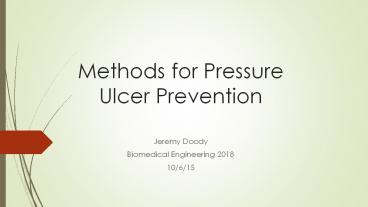Methods for Pressure Ulcer Prevention - PowerPoint PPT Presentation
Title:
Methods for Pressure Ulcer Prevention
Description:
Methods for Pressure Ulcer Prevention Jeremy Doody Biomedical Engineering 2018 10/6/15 What is an Ulcer? Also known as pressure sores or bed sores Occurs on bony area ... – PowerPoint PPT presentation
Number of Views:338
Avg rating:3.0/5.0
Title: Methods for Pressure Ulcer Prevention
1
Methods for PressureUlcer Prevention
- Jeremy Doody
- Biomedical Engineering 2018
- 10/6/15
2
What is an Ulcer?
- Also known as pressure sores or bed sores
- Occurs on bony area of body (ex hip)
- Damage to skin and tissue
- Elderly/bedridden people are more succeptable
- 4 stages of Ulcers
3
Solutions
- Detect and treat as early as possible
- Dressings (bandages)
- Topical Agents
- Turning to elleviate pressure spots
- Cleanliness
4
Comparing Topical Agents with Placebo
- Houwing study
- 4 week study split patients into 3 groups
- Intervention group- 29 patients given DMSO-cream
every 6 hours - Placebo group- 32 patients given a fake cream
every 6 hours - Control group- 18 patients given no cream
- All groups changed their lying position by 30
degrees every 6 hours
5
Results of Study
- 62.1 got ulcers in the intervention group
- 31.3 got ulcers in the placebo group
- 38.9 got ulcers in the control group
- Effectiveness based on risk ratio (RR)
- There was no statistically significant
difference in pressure ulcer incidence between
the intervention and the control group (RR 1.60,
95 CI 0.84 to 3.04). - There was no statistically significant
difference in pressure ulcer incidence between
the placebo and control group (RR0.80, 95 CI
0.37 to 1.74). - There was a statistically significant difference
in pressure ulcer incidence between the
intervention and the placebo group (RR 1.99,
95 CI 1.10 to 3.57).
6
Dressing vs. No Dressing
- Kalowes study
- This study followed up participants while in the
intensive care unit - average length of stay was 6.5 days (range was 0
to 120 days) - Intervention group- 169 patients had a dressing
applied to the skin covering the tailbone area - Control group- 166 patients had no dressing
applied.
7
Results of Study
- Intervention group- 0.4 got ulcers
- Control group- 4 got ulcers
- Effectiveness based on risk ratio (RR)
8
Conclusion
- Topical agents actually increased ulcers in
Houwing study - Topical agents vs. placebo was inconclusive
- Dressings decreased ulcer occurance in Kalowes
study - Dressings were effective in general
- Studies were inconsistent with each other (ex
follow up times)
9
The future
- Trials should be bigger to show more meaningful
results - More variables should be kept constant
- Better technology could create more effective
topical agents, dressings, or a combo of both.































